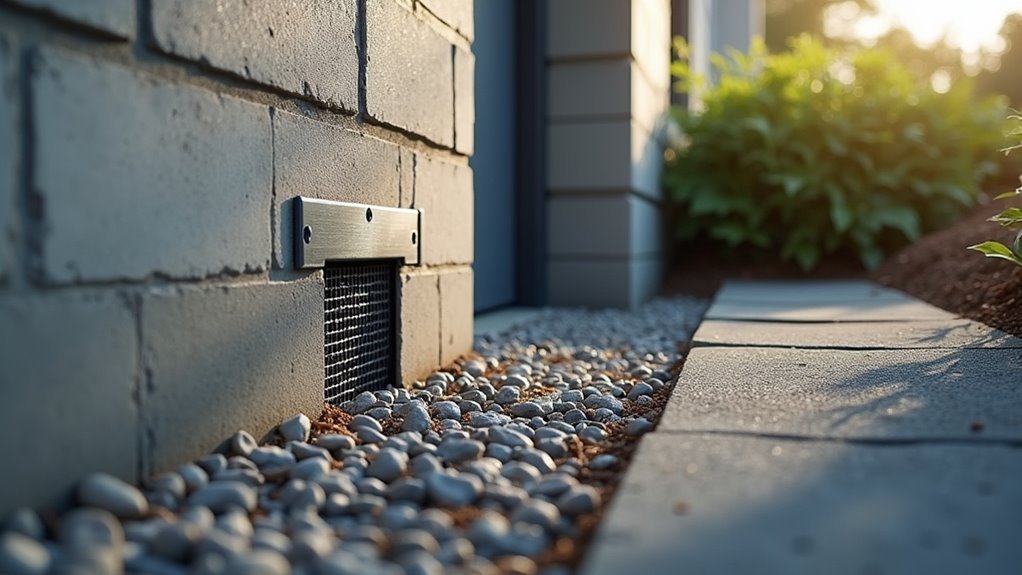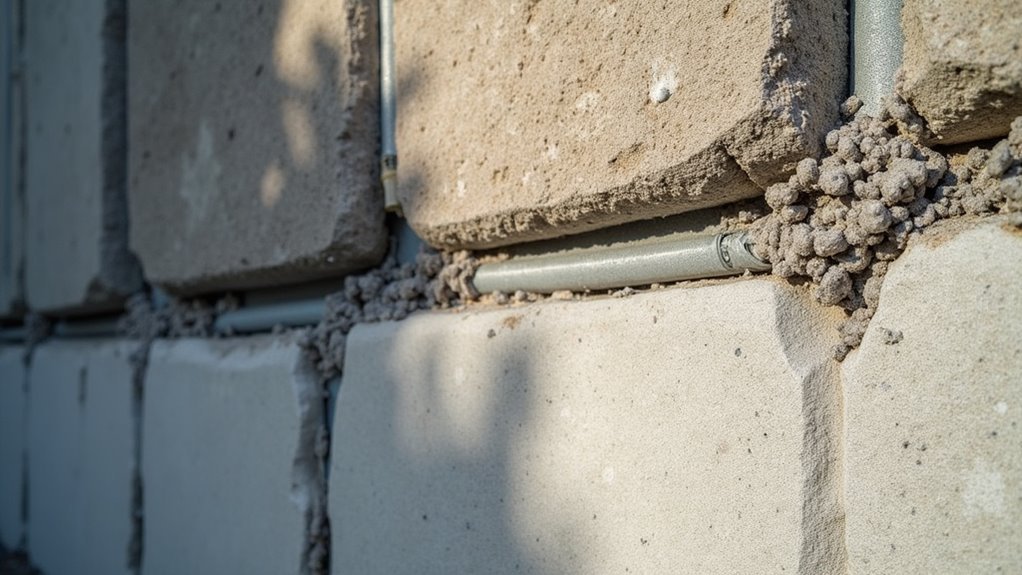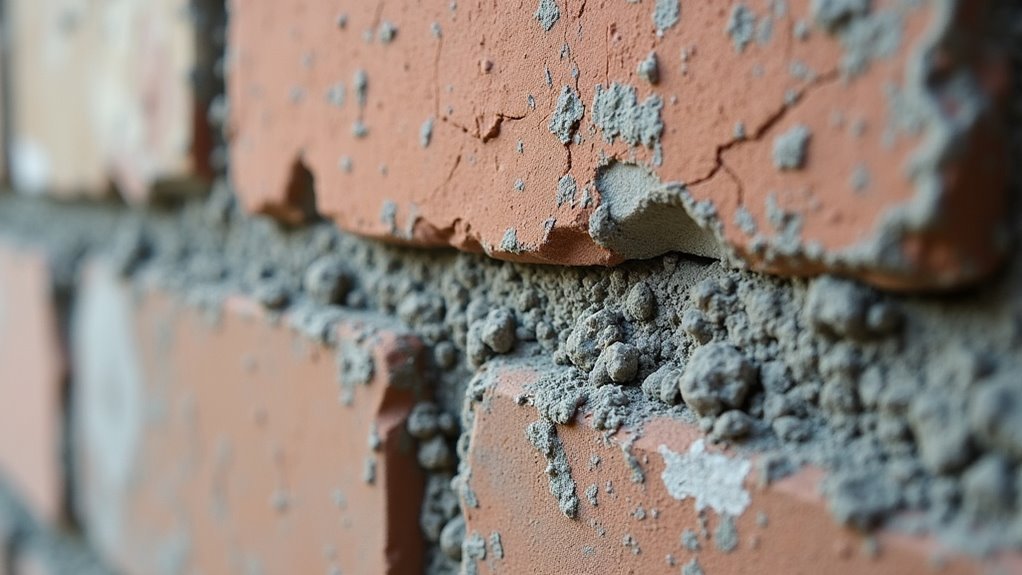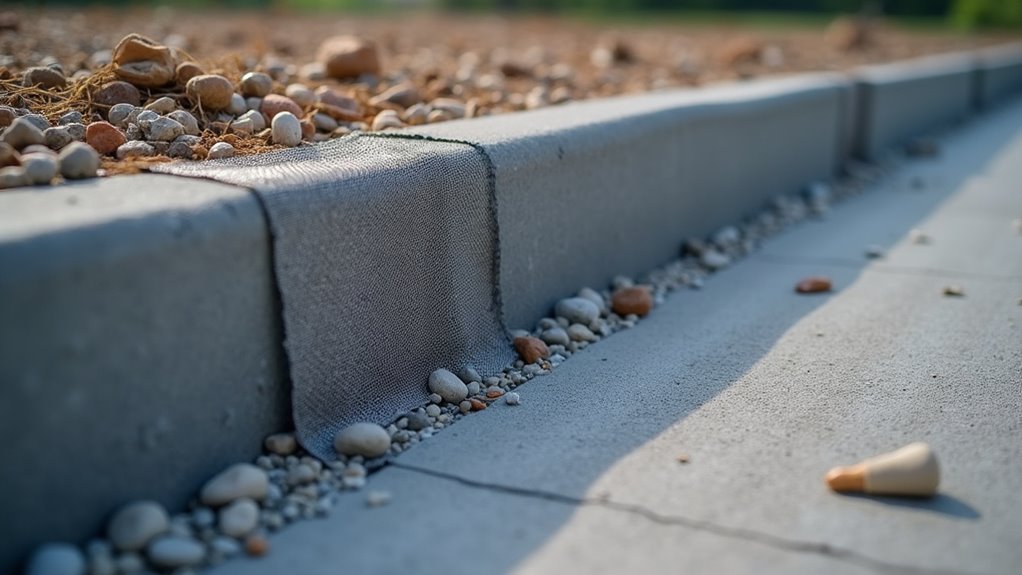A mouse-proof basement foundation requires sealing every crack and gap larger than 1/4 inch using a three-step process: backing material, chew-resistant copper mesh or Xcluder fabric, and high-quality sealant. You’ll need to address deteriorating mortar joints, utility penetration points around pipes and wires, and foundation settling cracks. Proper drainage that directs water away from your foundation eliminates the moisture that attracts rodents. The techniques below will show you exactly how to execute each critical step.
Understanding Why Mice Target Basement Foundations

When temperatures drop and outdoor conditions become harsh, mice instinctively seek out the warmth and safety that basement foundations provide. Your basement offers everything mice need for winter survival: stable temperatures, minimal human activity, and protection from predators.
Basements become winter havens for mice, offering warmth, shelter, and everything needed for survival during harsh outdoor conditions.
The dark, damp environment creates perfect conditions for nesting and reproduction. Mice are drawn to basements because they often contain abundant food sources, water from plumbing leaks, and nesting materials like cardboard boxes or fabric.
Since you rarely visit your basement during winter months, mice can establish colonies undetected. They’ll exploit foundation cracks and gaps as small as a quarter to gain entry.
Understanding these attraction factors helps you implement targeted strategies to prevent mice from entering your home through vulnerable foundation points.
Identifying Common Entry Points in Foundation Walls
You’ll need to systematically examine your foundation walls for three critical vulnerability areas that mice commonly exploit.
Start by checking for foundation cracks and gaps, then inspect deteriorating mortar joints where the binding material between stones or blocks has weakened over time.
Don’t overlook utility penetration points where pipes, wires, or cables enter your home, as these areas frequently develop gaps large enough for mice to squeeze through.
Foundation Cracks and Gaps
Although mice can squeeze through openings as small as a quarter-inch, foundation walls often contain numerous cracks and gaps that provide easy access points into your home.
These foundation cracks and gaps develop through natural settling, erosion, and aging of materials. You’ll commonly find vulnerabilities in deteriorating mortar joints between blocks or stones, where weather and time have worn away the binding material.
Pay special attention to areas around utility pipes entering your foundation, as these spots frequently have inadequate sealing.
If you live in an older home with terra cotta blocks, inspect these areas carefully since this material becomes particularly susceptible over time.
Additionally, check gaps beneath porches, decks, and settling concrete steps, as these locations create perfect entry points for rodents seeking winter shelter.
Deteriorating Mortar Joints
Deteriorating mortar joints rank among the most overlooked yet problematic entry points in foundation walls.
You’ll find that mice can squeeze through openings as small as 1/4 inch, making crumbling mortar an open invitation. Old lime-based mortars often deteriorate over time, turning to dust and creating perfect entry points for rodents.
Regular inspection of your foundation walls helps you identify compromised mortar before it becomes a major problem.
When you spot loose or crumbling material, you’ll need to address it quickly.
- Clean out all loose mortar completely before beginning repairs
- Apply durable Type 2 Portland cement to restore joint integrity
- Focus extra attention on older homes where foundation blocks commonly develop gaps
Timely repointing prevents structural compromise while eliminating rodent access points.
Utility Penetration Points
Three primary utility penetration points create the most vulnerable entry zones in foundation walls: electrical conduits, plumbing pipes, and HVAC connections. You’ll find these openings where utilities enter your basement through concrete or block walls. Since mice can squeeze through holes as small as 1/4 inch, even tiny gaps around these utility penetration points provide easy access.
| Utility Type | Common Gap Size | Sealing Method |
|---|---|---|
| Electrical | 1/4 – 1/2 inch | Expanding foam |
| Plumbing | 1/2 – 2 inches | Caulk + steel wool |
| HVAC | 1 – 3 inches | Metal flashing + sealant |
Deteriorating mortar around these areas creates larger openings over time. You should inspect these utility penetration points regularly and seal gaps immediately using appropriate materials. This prevents mouse entry while improving energy efficiency.
Inspecting Fieldstone and Masonry Foundation Vulnerabilities
You’ll need to carefully examine your fieldstone and masonry foundation for deteriorating mortar joints that can crumble into dust and create mouse-sized entry points.
Focus your inspection on loose or failing mortar between stones, paying particular attention to the bottom row where direct wall access is most likely.
These vulnerable areas require immediate attention through proper crack sealing and repointing techniques to maintain an effective barrier against rodent intrusion.
Deteriorating Mortar Joint Issues
When examining your basement foundation for potential mouse entry points, fieldstone and masonry walls demand special attention due to their susceptibility to mortar joint deterioration.
Old lime-based mortars can literally turn to dust over time, creating gaps as small as 1/4 inch that allow mice easy access to your basement. These deteriorating mortar joints compromise both structural integrity and pest control efforts.
You’ll need to inspect every joint carefully, looking for crumbling, missing, or loose mortar. Water intrusion accelerates this deterioration, making exterior groundwater management essential for long-term protection.
- Perform tuck pointing on badly deteriorated joints by cleaning out old mortar and replacing it with new material
- Apply high-quality sealants to small cracks that resist rodent chewing and provide water resistance
- Conduct regular maintenance inspections to catch deterioration early before it becomes a major problem
Foundation Crack Sealing Methods
Beyond deteriorating mortar joints, foundation cracks present another significant vulnerability that requires systematic sealing methods to prevent mouse infiltration.
When you discover cracks larger than 1/4 inch, you’ll need a structured approach for effective rodent control. Start by inserting backing material into the crack’s depth, then apply exclusion fabric as a barrier layer. Finish with high-quality sealant to create a complete seal.
You should examine masonry foundations thoroughly, focusing on utility entries and areas where different materials meet. These connection zones are common weak points for mouse access.
Foundation crack sealing methods work best when you incorporate copper mesh and other durable exclusion materials that resist rodent chewing better than traditional sealants alone.
Essential Materials for Foundation Sealing and Repairs

While proper technique matters greatly, selecting the right materials forms the foundation of any successful mouse-proofing project.
You’ll need high-quality sealants that bond better than traditional caulk and resist rodent damage. These specialized products provide both rodent resistance and water protection for your foundation.
For gaps larger than 1/4 inch, you’ll require backing material, exclusion materials, and durable sealants. Consider copper mesh and Xcluder fabric since mice can’t chew through these materials effectively.
Steel wool works temporarily for indoor applications, but avoid using it outdoors where rusting creates staining risks.
Essential materials include:
- High-quality sealants – Superior bonding and rodent resistance compared to standard caulk
- Copper mesh and Xcluder fabric – Chew-resistant exclusion materials for extensive gap coverage
- Rust-resistant materials – Essential for exterior applications to prevent staining and deterioration
Step-by-Step Foundation Crack Sealing Techniques
Once you’ve gathered your materials, begin by conducting a thorough inspection of your foundation’s exterior and interior surfaces. Look for cracks and gaps around the foundation that are larger than 1/4 inch, as these create easy access points for mice.
Clean out any deteriorated mortar from cracks before starting repairs to guarantee proper adhesion.
Clean out all deteriorated mortar from foundation cracks before beginning repairs to ensure proper sealant adhesion and long-lasting results.
Follow a three-step sealing process: first, fill the gap with backing material, then enmesh with copper mesh or Xcluder fabric, and finally apply high-quality sealant for lasting protection.
For larger cracks, use tuck pointing to replace old mortar and match existing color for aesthetic consistency.
Remember to regularly inspect and maintain sealed areas, since temperature and moisture fluctuations can create new cracks and potential rodent entry points.
Proper Mortar Repair and Tuck Pointing Methods

Effective tuck pointing begins with removing all loose and deteriorated mortar from the joints using a chisel, grout saw, or angle grinder with a masonry blade.
Clean out the joints thoroughly to guarantee strong adhesion of your new material during this critical mortar repair process.
Use Type 2 Portland cement for enhanced durability in stone foundations, as it withstands environmental stresses better than traditional lime-based mortars.
Match your new mortar color to existing material for aesthetic consistency and seamless appearance.
- Apply high-quality sealants on small gaps and cracks to prevent rodent entry and add water resistance
- Inspect mortar joints regularly since even tiny gaps become mouse entry points
- Complete tuck pointing promptly when deterioration appears to maintain structural integrity
Sealing Gaps Around Utility Penetrations
You’ll find that utility lines entering your basement create some of the most vulnerable entry points for mice, as these penetrations often leave gaps large enough for rodents to squeeze through.
Understanding where these common entry points occur and selecting the right sealing materials will determine your success in blocking these access routes.
We’ll walk through identifying these penetrations, choosing appropriate materials like steel wool or copper mesh, and implementing a systematic sealing process to secure your foundation.
Common Utility Entry Points
Among the most overlooked entry points in basement foundations are the gaps surrounding utility penetrations where pipes, electrical conduits, and cables pass through walls.
These openings create perfect highways for mice since they’re often larger than the actual utilities passing through them. You’ll typically find these vulnerable spots where water lines, gas pipes, electrical wiring, internet cables, and HVAC ducts enter your basement.
Common locations to inspect include:
- Water and sewer line entries – Usually found near your water heater or utility room
- Electrical panel connections – Where main electrical feeds enter the foundation
- HVAC and gas line penetrations – Often clustered together on exterior walls
Proper Sealing Materials
When selecting materials to seal utility penetrations, copper mesh stands out as your most reliable defense against determined mice.
You’ll want to avoid foam sealants alone since they’re easily chewed through. Instead, choose proper sealing materials like Xcluder fabric or copper scrubbing pads that provide superior adhesion and chewing resistance.
For gaps larger than 1/4 inch, you’ll need a three-step approach: first add backing material, then enclose it with exclusion material, and finally apply a durable sealant.
This layered method maximizes effectiveness against mouse entry.
Remember that proper sealing materials not only prevent rodent access but also improve your basement’s energy efficiency by reducing drafts and moisture infiltration, making your investment doubly worthwhile.
Step-by-Step Sealing Process
Start by conducting a thorough inspection of your basement’s utility penetrations, examining where pipes, electrical conduits, and cables enter through the foundation walls.
Look for gaps as small as 1/4 inch, which provide easy mouse access.
Follow this step-by-step sealing process to mouseproof your basement effectively:
- Fill larger gaps with backing material like steel wool or copper mesh before applying any sealant.
- Install exclusion fabric such as Xcluder material over the backing to create a durable mesh barrier.
- Apply high-quality sealant over the entire area, ensuring foam-only solutions are covered with additional protective coating.
Use copper mesh and Xcluder fabric as your primary materials since they resist rodent chewing.
Remember that foam alone won’t prevent entry.
Regularly inspect these sealed areas for deterioration or new gaps that could compromise your rodent-proof barrier.
Basement Window and Door Frame Security
Since mice can squeeze through openings as small as 1/4 inch in diameter, you’ll need to carefully inspect every window and door frame in your basement for potential entry points.
Look for gaps or cracks that could compromise your mice control efforts. Focus on door thresholds, ensuring they’re tightly sealed without gaps.
Examine every gap and crack thoroughly – even the smallest opening can undermine your entire rodent prevention strategy.
Install tight-fitting screens on basement windows to block access while maintaining ventilation. Check weather stripping around doors and windows regularly, replacing worn sections to maintain secure seals.
For enhanced protection, use steel mesh or copper mesh to reinforce gaps in window frames. These materials resist rodent chewing and provide effective long-term security.
Pay special attention to corners and joints where frames meet walls, as these areas commonly develop gaps over time.
Managing Water Issues That Attract Rodents
Water problems in your basement create an open invitation for mice and other rodents looking for reliable hydration sources. Standing water and leaks transform your basement into an attractive habitat where mice can thrive.
Effective water management starts with controlling moisture at its source and eliminating pooling areas that draw unwanted guests.
- Direct downspouts 6-10 feet away from your foundation to prevent water accumulation near potential entry points
- Maintain well-drained window wells above ground level to eliminate water pooling that attracts shelter-seeking rodents
- Regrade ground around your foundation to eliminate shallow areas and prevent water intrusion that creates ideal nesting conditions
Regularly inspect and repair foundation cracks, as water exploits these openings to create perfect rodent habitation zones.
Foundation Drainage and Grading Considerations
While moisture control addresses immediate water problems, proper foundation drainage and grading create the long-term defense system that keeps your basement dry and rodent-free.
You’ll need to guarantee your foundation drainage system directs water away from your home’s base. Grade the soil around your foundation so it slopes away from the house, preventing water from pooling near vulnerable areas where mice might enter. Extend your downspouts at least 5 to 10 feet from the foundation to effectively divert rainwater.
Keep window wells above ground level with proper drainage to prevent water accumulation. Regrade any shallow or hollow areas adjacent to your home, as these spots collect water that attracts rodents seeking shelter and creates entry opportunities through compromised foundation materials.
Professional Vs DIY Foundation Mouse-Proofing
When deciding between professional services and DIY approaches for foundation mouse-proofing, you’ll face an essential choice that affects both your budget and long-term protection.
Professional pest control companies bring specialized expertise and superior materials to the task. They’ll conduct thorough inspections to identify hidden entry points you might miss, including gaps around utility pipes and deteriorating mortar.
Licensed professionals use advanced materials like copper mesh and high-quality sealants that bond better than standard caulk, ensuring lasting protection.
DIY methods often fall short because:
- Standard foam and caulk deteriorate over time and aren’t truly rodent-proof
- You may overlook critical entry points during inspection
- Inadequate sealing leaves openings mice can exploit (they fit through 1/4-inch holes)
Professional services provide tailored solutions for your specific foundation type, minimizing future infestation risks.
Long-Term Foundation Maintenance for Rodent Prevention
Effective mouse-proofing requires ongoing vigilance beyond the initial installation, as foundations naturally shift and deteriorate over time.
You’ll need to inspect mortar joints quarterly, checking for gaps larger than 1/4 inch that create new entry points. When you discover deteriorating mortar, implement tuck pointing immediately to maintain structural integrity and rodent exclusion.
Don’t neglect your drainage systems—ensure downspouts direct water away from the foundation to prevent weakening that creates additional vulnerabilities.
Replace worn sealants with high-quality materials like copper mesh and Xcluder fabric that resist chewing damage.
Schedule annual inspections of basement vents and access points, verifying screens remain intact and properly secured.
This proactive maintenance approach prevents small foundation issues from becoming major rodent highways into your home.
Frequently Asked Questions
What to Put Around Foundation to Keep Mice Away?
You’ll want to install 1/4 inch hardware fabric around your foundation and seal any gaps larger than 1/4 inch with copper mesh or quality sealants to effectively block mice entry points.
What Material Can Mice Not Chew Through?
You can’t go wrong with steel, copper mesh, or heavy-duty plastic since mice can’t chew through these materials. Concrete, masonry, and quarter-inch hardware cloth also create impenetrable barriers against determined rodents.
Can Mice Chew Through a Cinder Block?
You can’t chew through solid cinder blocks – they’re too dense and hard for your teeth. However, you’ll exploit gaps, cracks, or deteriorated mortar joints between blocks to gain entry.
What Is the Fastest Way to Get Rid of Mice in the Basement?
You’ll eliminate mice fastest by setting snap traps where you’ve spotted droppings or gnaw marks. Seal entry points immediately since mice squeeze through quarter-sized holes, and remove food sources to prevent their return.
In Summary
You’ve now got the knowledge to tackle foundation mouse-proofing head-on. Start by sealing those obvious cracks and gaps, then address drainage issues that’re drawing rodents to your basement. Don’t forget regular inspections—catching problems early saves you time and money later. Whether you’re tackling this project yourself or hiring professionals, remember that consistent maintenance is what’ll keep your foundation mouse-proof for years to come.





Leave a Reply